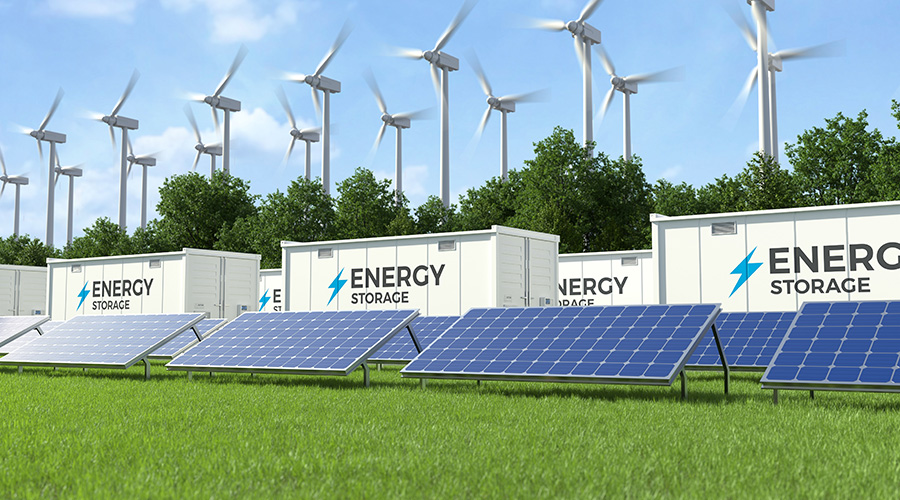4 Benefits of Pairing Solar with Battery Storage for Commercial Facilities

While solar clearly has advantages as a renewable energy source, its greatest potential for reducing emissions, lowering energy costs, improving operations, and more, lies in pairing solar power with energy storage.
This is how it works: Rooftop solar panels on a facility generate clean power during the day and the battery storage system, often made of lithium-ion batteries, collects the energy for future, strategic use. This powerful combination opens the door for facilities to realize additional benefits. Here are four:
- Backup Power for Seamless Operations: Solar energy systems have built-in safety measures in the event of power grid outages, switching off to safeguard workers who work to restore power. In this scenario, the battery storage system releases energy until the grid is back up, powering essential operations, which allow businesses to continue running and avoid downtime.
- More Energy Cost Savings: With solar-and-battery systems, businesses can hold onto surplus energy for future use. For example, businesses can rely on this stored energy before turning to the grid, enjoying cost-saving benefits. Businesses can achieve even further savings through strategic use of this stored energy. Peak shaving offers a cost-cutting strategy where businesses use solar energy stored in batteries instead of the electrical grid during periods of peak demand when grid-power charges are at their highest. Another technique is load shifting, which allows businesses to shift their electricity consumption to low- or off-peak hours when rates are cheaper.
- Greater Reduction in Carbon Emissions: Solar with battery storage systems can reduce carbon emissions by a factor of 20 compared to solar alone. This powerful combination, which allows businesses to create their own clean energy while reducing reliance on carbon-emitting sources, unlocks new potential as more and more businesses set ambitious ESG (Environmental, Sustainability, Governance) goals in the years ahead. There’s no doubt that solar energy systems enhance public perception and investor confidence in a company’s commitment to cleaner energy.
- Investments that Pay for Themselves: Substantial cost savings in the form of lower solar power costs and financial incentives mean solar-and-storage investments are well poised to pay for themselves within their 25-plus-year lifespan. Consider this trend: For commercial buildings ranging in size from 100 kW–2MW, the cost benchmark of a photovoltaic system dropped 10.71 percent from 2020 to 2021, according to a 2021 report from the National Renewable Energy Laboratory (NREL). Plus, federal and state governments are actively pushing companies to shift to solar through incentive programs. The Inflation Reduction Act increases the solar investment tax credit (ITC) to 30% for projects that begin before January 1, 2025, and meet apprenticeship and wage requirements. States are encouraging companies to transition, too, offering further incentives: Several states have net metering programs, which allow solar owners to receive credits on their bills in exchange for sending surplus energy to the grid. Additionally, many states have their own incentive initiatives, such as Illinois with The Climate and Equitable Jobs Act (CEJA), the Illinois Clean Energy Community Foundation (ICCF), and the Illinois Solar for All program.
Given all the benefits of solar integrated with batteries, facility managers might wonder how they can begin their transition. To maximize results, it’s recommended to first reduce the facility’s solar power needs. This can be achieved through steps like retrofitting facilities with LEDs, adding insulation and upgrading HVAC systems. At the outset of a project, it’s also critical to select a qualified electrical contractor who has experience with solar and energy storage systems to ensure a safe, effective and efficient installation. Reputable sources, such as the National Electrical Contractors Association’s (NECA) Find A Contractor tool and Powering Chicago’s Find a Contractor Tool, for those in the Chicagoland area, can identify qualified contractors with the right credentials, like NABCEP board certification for solar professionals, for your next project.
By Elbert Walters III, Contributing Writer
Elbert Walters III is trained as an electrician at the IBEW-NECA Technical Institute in Alsip, Illinois, and now represents the electrical construction industry as the executive director of Powering Chicago.
The post "4 Benefits of Pairing Solar with Battery Storage for Commercial Facilities" appeared first on Building Operating & Management

